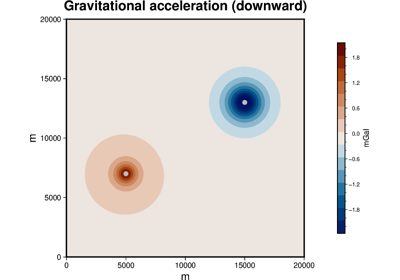harmonica.point_gravity#
- harmonica.point_gravity(coordinates, points, masses, field, coordinate_system='cartesian', parallel=True, dtype='float64')[source]#
Compute gravitational fields of point masses.
Compute the gravitational potential, gravitational acceleration and tensor components generated by a collection of point masses on a set of observation points defined either in Cartesian or geocentric spherical coordinates.
Warning
The vertical direction points upwards, i.e. positive and negative values of
upwardrepresent points above and below the surface, respectively. Butg_zfield returns the downward component of the gravitational acceleration so that positive density contrasts produce positive anomalies. The same applies to the tensor components, i.e. theg_ezis the non-diagonal easting-downward tensor component.Important
The gravitational potential is returned in \(\text{J}/\text{kg}\).
The gravity acceleration components are returned in mGal (\(\text{m}/\text{s}^2\)).
The tensor components are returned in Eotvos (\(\text{s}^{-2}\)).
- Parameters:
- coordinates
listofarrays List of arrays containing the coordinates of computation points in the following order:
easting,northingandupward(if coordinates given in Cartesian coordinates), orlongitude,latitudeandradius(if given on a spherical geocentric coordinate system). Alleasting,northingandupwardshould be in meters. Bothlongitudeandlatitudeshould be in degrees andradiusin meters.- points
listorarray List or array containing the coordinates of the point masses in the following order:
easting,northingandupward(if coordinates given in Cartesian coordinates), orlongitude,latitudeandradius(if given on a spherical geocentric coordinate system). Alleasting,northingandupwardshould be in meters. Bothlongitudeandlatitudeshould be in degrees andradiusin meters.- masses
listorarray List or array containing the mass of each point mass in kg.
- field
str Gravitational field that wants to be computed. The available fields coordinates are:
Gravitational potential:
potentialEasting acceleration:
g_eNorthing acceleration:
g_nDownward acceleration:
g_z- Tensor components:
g_eeg_nng_zzg_eng_ezg_nz
- coordinate_system
str(optional) Coordinate system of the coordinates of the computation points and the point masses. Available coordinates systems:
cartesian,spherical. Defaultcartesian.- parallelbool (
optional) If True the computations will run in parallel using Numba built-in parallelization. If False, the forward model will run on a single core. Might be useful to disable parallelization if the forward model is run by an already parallelized workflow. Default to True.
- dtypedata-type (
optional) Data type assigned to resulting gravitational field. Default to
np.float64.
- coordinates
- Returns:
- result
array Gravitational field generated by the
point_masson the computation points defined incoordinates. The potential is given in SI units, the accelerations in mGal and the Marussi tensor components in Eotvos.
- result
Notes
The gravitational potential field generated by a point mass with mass \(m\) located at a point \(Q\) on a computation point \(P\) can be computed as:
\[V(P) = \frac{G m}{l},\]where \(G\) is the gravitational constant and \(l\) is the Euclidean distance between \(P\) and \(Q\) [Blakely1995].
In Cartesian coordinates, the points \(P\) and \(Q\) are given by \(x\), \(y\) and \(z\) coordinates, which can be translated into
northing,eastingandupward, respectively. If \(P\) is located at \((x, y, z)\), and \(Q\) at \((x_p, y_p, z_p)\), the distance \(l\) can be computed as:\[l = \sqrt{ (x - x_p)^2 + (y - y_p)^2 + (z - z_p)^2 }.\]The gradient of the potential, also known as the gravitational acceleration vector \(\vec{g}\), is defined as:
\[\vec{g} = \nabla V\]and has components \(g_{northing}(P)\), \(g_{easting}(P)\) and \(g_{upward}(P)\) given by
\[g_{northing}(P) = - \frac{G m}{l^3} (x - x_p),\]\[g_{easting}(P) = - \frac{G m}{l^3} (y - y_p)\]and
\[g_{upward}(P) = - \frac{G m}{l^3} (z - z_p).\]We define the downward component of the gravitational acceleration as the opposite of \(g_{upward}\) (remember that \(z\) points upwards):
\[g_{z}(P) = \frac{G m}{l^3} (z - z_p).\]On a geocentric spherical coordinate system, the points \(P\) and \(Q\) are given by the
longitude,latitudeandradiuscoordinates, i.e. \(\lambda\), \(\varphi\) and \(r\), respectively. On this coordinate system, the Euclidean distance between \(P(r, \varphi, \lambda)\) and \(Q(r_p, \varphi_p, \lambda_p)\) can be calculated as follows [Grombein2013]:\[l = \sqrt{ r^2 + r_p^2 - 2 r r_p \cos \Psi },\]where
\[\cos \Psi = \sin \varphi \sin \varphi_p + \cos \varphi \cos \varphi_p \cos(\lambda - \lambda_p).\]The radial component of the acceleration vector on a local North-oriented system whose origin is located on the point \(P(r, \varphi, \lambda)\) is given by [Grombein2013]:
\[g_r(P) = - \frac{G m}{l^3} (r - r_p \cos \Psi).\]We define the downward component of the gravitational acceleration \(g_z\) as the opposite of the radial component:
\[g_z(P) = \frac{G m}{l^3} (r - r_p \cos \Psi).\]Warning
When working in Cartesian coordinates, the z direction points upwards, i.e. positive and negative values of
upwardrepresent points above and below the surface, respectively. But remember that theg_zfield returns the downward component of the gravitational acceleration.Warning
When working in geocentric spherical coordinates, remember that the
g_zfield returns the downward component of the gravitational acceleration on the local North oriented coordinate system. It is equivalent to the opposite of the radial component, therefore it’s positive if the acceleration vector points inside the spheroid.
